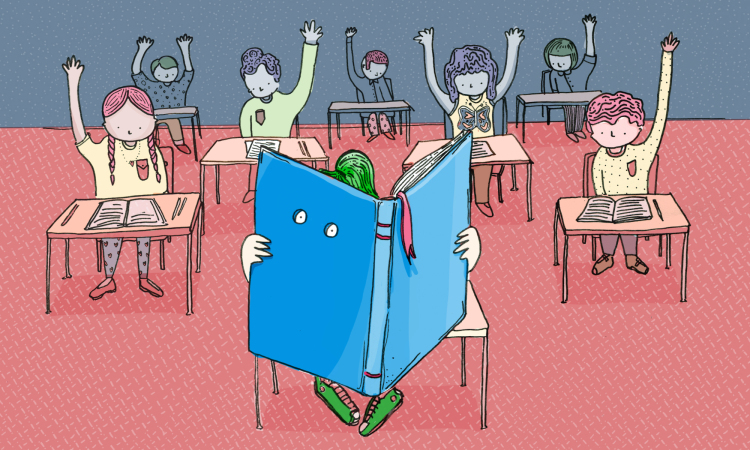The term introvert was coined in the 1920s by psychologist Carl Jung to describe a person who becomes emotionally and physically worn out from being around people a long time. Introverted kids are often misunderstood and are viewed as standoffish, rude or anxious, and many are mislabeled as shy.
Shyness and introversion aren’t the same thing
It is estimated that as many as 4 out of 10 people will be introverted. In a class of 30 learners, that’s 12 children.
While extroverted children draw energy from those around them and thrive in these action- packed school schedules, the very same schedule depletes introverted children.
They are left feeling over-stimulated, emotionally exhausted and ready to melt down.
Teachers absolutely love the quiet children, the ones who make minimal demands on their precious teaching time, never put their hands up or ask questions.
They can sit still on their chair for lengthy periods of time and can work on a task without disruption until completion.
These are the “perfect pupils” that everyone wishes for every year, because they make life as a teacher, more bearable.
On the other hand, what happens if these same quiet ones are not coping academically? They are easy to overlook because they hardly ever ask anything. They literally disappear into the busy, colourful, creative walls of the classroom.
HOW DOES A CHILD BECOME INTROVERTED? The simple answer is that they’re born that way.
Introversion is part of one’s temperament—traits that are part of you from birth.
Often parents introducing their child to the teacher at the beginning of the school year will say things like:
“She’s finally starting to come out of her shell.”
“It just takes him a little longer to warm up to others.” “She’s more of a listener than a talker.”
“He likes to take in what’s going on before joining others.” “She prefers to hang out with one friend at a time.”
“He’s just quiet.”
Be a careful observer in your classroom and out on the playground at break time
These kids won’t be running around shouting and letting off steam, they’ll be sitting quietly on a bench either reading a book or chatting to a friend, or they’ll be walking around looking for bugs in the ground.
As teachers, we must make a concerted effort to make the classroom a safe and happy place for all personalities, including the quiet, reserved ones.

Tips for teachers:
1) Make sure to build quiet time into the school day, especially when kids are younger.
2) Provide alternatives to recess, which for many students is unnecessarily chaotic and not that interesting. Open up a classroom and let students sit and play board games in small groups, or read a book, or just hang out and chill.
3) Encourage interests and encouraging them to speak to their interests will help them learn to turn up the volume, but putting them on the spot without any warning is likely to trigger feelings of anxiety.
4) Pose a question but give kids a certain amount of time to consider the question before raising their hands to speak, kids learn to think first.
This also gives introverted kids a chance to collect their thoughts and join the classroom conversation.
5) Use a buddy system by pairing off like-minded kids with similar interests and personalities helps introverted kids find the friendly face.
- This will also prove helpful during more chaotic periods, such as lunch and recess.
6) Allow choices that encourage students to pick the amount of stimulation that is right for them in that moment, i.e. listening to music while working vs needing quiet, working in a group or by themselves.
7) Balance group work, solo projects and working in pairs as far as possible. Not every single activity has to be collaborative.
- Think-Pair-Share is a great technique to encourage thoughtful processing and quiet discussion before announcing anything to a larger group.
8) Use tools and technology that allow students to participate through their electronic devices as opposed to raising their hand.
- Apps that allow students to contribute to class discussions, sometimes anonymously and sometimes not.
9) For the high schoolers, encourage online communication via email, as this allows a level playing field as opposed to expecting the learners to express themselves in front of the class.
10) Celebrate different personalities and encourage a culture of love and acceptance. Move away from a one-size-fits-all approach. It doesn’t belong here anymore.
References for this article:
- Larson, E. 2018. Raising an Introvert In an Extrovert World
- Rebel Circus
- HuffPost
- Watson, A. 2014 – Introverts in the classroom: supporting the “quiet kids” (and possibly yourself!)
Author: Director at Elsen Academy, Port Elizabeth – Philippa Fabbri
For great savings on life’s little pleasures visit Bargain Buys! Enjoy food and travel, then visit Home Food and Travel. Know somebody who is getting married, Wedding and Function can assist.
Enjoy reading this article? For more articles like this click here









